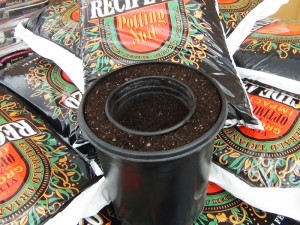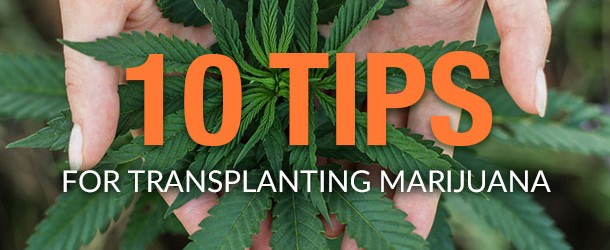When it’s time to transplant into larger containers, your choice of container size, container setup, and your transplant method are all important factors. Each can impact the success of your transplant. Since I have have quite a bit of experience with this, I thought I’d share a few tips to help you successfully transplant your young marijuana plants. Some of these tips are common sense while others may be new even for experienced growers.
1. Pot size selection
A great rule of thumb is to choose a new pot that is at least double the size of the old one. Avoid potting up into a huge pot, If you place a 6-pack sized root ball into a 5 gallon pot you’ll have to keep 5 gallons of soil moist which at first the roots won’t reach. This is a waste of water and plant food. Larger pots will also require greater spacing which for indoor growing means more lights and wasted electricity.
2. Assess root ball condition
If your plant has become overly root bound in its old pot, consider breaking up the root ball a little. Gently pull it apart just enough to break the shape of the old pot. Some roots will be damaged but in the long run it will help the roots break out of the old pot shape and aid in root expansion.
3. Avoid Stress
Be sure not to transplant in direct sunlight. Roots don’t like direct light or exposure to dry conditions. Transplant in the early morning or better yet the evening. If possible, allow freshly transplanted plants to remain in their old environment for a day or two before moving them into new conditions.
4. Stake plants
If the plants are tall and delicate, or have a hard time standing on their own, stake them with bamboo and secure with at least 2 plant ties. This helps prevent them from being overturned if jostled. As the plant develops, be sure to remove these ties or they will become tight and even girdle the plant.
5. Rapid potting trick
 If you have a lot of plants to transplant consider pre-filling the new containers with fresh planting mix. Use an empty pot, that is the same size as your old pots as a spacer to create a perfectly sized socket for the root ball to fit into. Simply stage the filled, new pots off to one side and remove the ‘spacer’ just prior to the actual transplanting action. This trick can save a lot of time and minimizes air and light exposure which reduces plant stress (see tip 3). Pots can even be filled and staged days before the actual transplant.
If you have a lot of plants to transplant consider pre-filling the new containers with fresh planting mix. Use an empty pot, that is the same size as your old pots as a spacer to create a perfectly sized socket for the root ball to fit into. Simply stage the filled, new pots off to one side and remove the ‘spacer’ just prior to the actual transplanting action. This trick can save a lot of time and minimizes air and light exposure which reduces plant stress (see tip 3). Pots can even be filled and staged days before the actual transplant.
6. Do not overly pack the soil
The first time you water the plants the soil settles and natural compacts. this is the ideal amount of compaction for most soils. If you under pack the pots, they might settle to be only half full. If pots are over compacted, the new roots will have to work harder to branch out. Compacting the soil just right takes a little practice and varies with soil moisture content and texture.
7. Always water immediately following transplant
The first watering helps settle the soil around the root ball and collapses any voids that may have formed inside the container, it also helps the young plant cope with transplant stress. Use a watering wand with a gentle diffuser to avoid upsetting the soil and root ball.
8. Post-transplant shock reduction
The only thing plants need after transplant is water. That being said, there are many products that claim to reduce transplant shock. To list a few; Superthrive, Liquinox b1, and Dyna Gro KLN. They all contain a plant growth regulator (PGR) called naphthylacetic acid (NAA). This PGR is also found in many cloning solutions. NAA is very powerful and actually forces the plant to abandon vegetative growth and focus only on root development. If any of these items are used, be sure to follow the labels instructions. Don’t use too much.
9. Post transplant Fertilizer
I don’t recommend use of liquid fertilizer for the first 2 watering. Fresh soil typically contains everything the plant needs for at least 3 weeks. There are of course exceptions to this. Some lower end soils may be nutritionally void, while other mixes are intentionally made this way, i.e. ProMix HP, Sunshine #2, and other peat/perlite blends. These mixes can be amended with dry organic additives, or supplemented with ¼-½ strength liquid fertilizer. Other growers recommend ¼-½ strength bloom food at this time because the additional phosphorus and potassium can aid in root development.
10. Listen to Music
This might seem like an odd one but transplanting can be both stressful and monotonous. Some good tunes will get you in a rhythm, help you relax and make the time go by a lot quicker.
I hope some of these tips help you out. Transplanting can definitely be a little tricky and a bit nerve racking at first. With a little practice and the the help of these tips you’ll be in new pots in no time. Please feel free to post any questions or additions you might have.
10 Tips for Transplanting Marijuana,













I’m a first time grower. I’ve got one indoors an one outdoors. I’m growing to compare the two differences myself. I keep reading over everyone’s post an adding some to my own growth. I leave in PA. Weather is great around here. Soil is even better. It’s been two months an both plants have stopped growing at 18″ long. Leaves are nicely green. I can’t seem to get them to grow any more. Should I start flowering the one indoors? Just let the outdoors one go on its own. I would like to have a good yeild for my first time, but I just want them to bud that’s all. Any words of wisdom is well appreciated. Thanks.
Cut up old panty hose, in strips as ties to the plant. Stretch it up to desire length. The nylon will not hurt the stems. As plant grows, the nylon will not pinch the plant.
Great idea! Now if only I had some old pantyhose 🙂
That is a good thought..thxs..
Thank so much for tips. My first grow has me stressed out but you guys make things a lot easier. Ty ☆☆☆☆☆
How old, tall, or developed should my clones be before transplanting into a larger pot (out of the Solo cup starter)?
Clones can be transplanted as soon as they are rooted.
Hi, that is a good idea. This is my first time trying to grow plants. Out of 5 seeds I have only two that are growing quite well. Not fast at all. I planted the seeds with the tap root in those little peat pots , maybe two inches high and maybe a little less than 2 inches in diameter. One plant has just sprouted its 5th and 6th leaves, and the other is bigger and the 5th and 6th leaves have been out for maybe a week and half. I just don’t know if I have to fertilize and when to transplant them. I am growing them in a green house, and we are on Vancouver Island and it doesn’t ever get cold here, so it think they will be good. Just not sure what to do next or when to do it, fertilizer and what size to transplant into.
Hope you can help. thanks
sue
Hi Sue,
You can pretty much treat them as any other plant you’ve grown in the past. Peat pots usually don’t contain much nutrients of their own so if you do use fertilizer, use a very watered down formula. You can transplant as soon as the roots being to reach the edge of the current container.